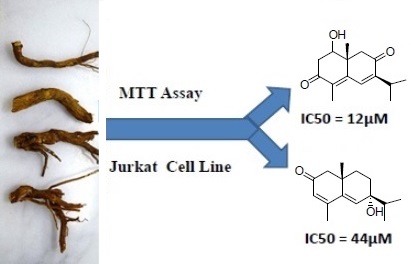JOURNAL 969
Records of Natural Products
Year: 2019 Issue: 4 July-August
p.307 - 315
Viewed 4015 times.
-
Ammar Bader

-
Qasem Abdallah

-
Mohamed I.S. Abdelhady

-
Nunziatina De Tommasi

-
Nicola Malafronte

-
Usama Shaheen

-
Majdi Bkhaitan

-
Roberta Cotugno

GRAPHICAL ABSTRACT

ABSTRACT
According to the World Health Organization Cancer is the second leading cause of death globally. The methanol extracts of fourteen Middle-Eastern plants of the family Asteraceae were screened for antiproliferative activity on five cancer cell lines (A2780, MCF7, HeLa, RKO and Jurkat) by using MTT assay. Psiadia punctulata (DC.) Vatke was selected for isolation and elucidation of the bioactive constituents by 1D- and 2D-NMR, and MS analyses. Flow cytometry was used to evaluate cell cycle analysis, apoptotic hallmarks and reactive oxygen species. P. punctulata yielded a new sesquiterpene characterized as 7-hydroxy eudesman-3,5-dien-2-one (punctulin) (3) and three known sesquiterpenes: 1, 2 and 4. The antiproliferative activity of all sesquiterpenes was evaluated in Jurkat (T-cell leukemia) and HeLa cancer cell lines. Compound 1 (1β-hydroxy-8-oxo-cyperone) has induced a significant growth inhibition in Jurkat and HeLa cells (IC50 =12 and 18µM respectively). Flow cytometry of compound 1 has elucidated the mechanism of action by showing its ability to induce cell cycle arrest in Jurkat cells mainly in G0/G1 and, less markedly, in G2/M. Compound 1 also expressed strong antioxidant activity by reducing the basal level of peroxides DHFDA-load in Jurkat cells. Compound 1 antioxidant activity may have contributed to the observed cell cycle arrest.
KEYWORDS- Cytotoxic Activity
- Asteraceae
- Leukemia
- Cell cycle
- Sesquiterpenes